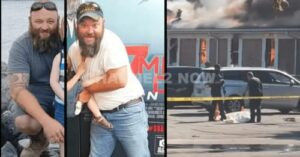GRAND BLANC, Mich. — Authorities have confirmed the identity of the suspect accused in Sunday’s mass shooting and arson at The Church of Jesus Christ of Latter-day Saints in Grand Blanc. The man has been identified as 40-year-old Thomas Jacob Sanford, a resident of Burton, Michigan. The violent incident has left a trail of devastation in both the church and the wider community, sparking grief, fear, and outrage.

The shooting erupted during a Sunday morning worship service, shattering the calm atmosphere inside the sanctuary. Witnesses reported that Sanford entered armed with multiple weapons, firing indiscriminately at congregants before flames were spotted spreading through the building. Chaos ensued as terrified worshippers scrambled to escape both the gunfire and the thick smoke that quickly filled the space.
Emergency calls flooded dispatchers as local law enforcement, fire units, and EMS rushed to the scene. First responders were forced to split efforts between neutralizing the threat, evacuating survivors, and containing the blaze. Multiple victims were pulled from the building, with some suffering from gunshot wounds and others battling burns and smoke inhalation. Officials have yet to release the official number of fatalities but confirmed that multiple people died in the assault.
As the sanctuary burned, Sanford reportedly fled, prompting a multi-agency manhunt that extended into Burton. Within hours, investigators tracked the suspect to a residence listed under his name on Atherton Road. The home, located at 4156 Atherton Road, was immediately cordoned off by police as specialized units and forensic investigators searched for weapons, documents, and digital evidence tied to the attack.
Neighbors in Burton described the heavy police presence as “unsettling” and “overwhelming.” Patrol cars, tactical vehicles, and crime scene units surrounded the quiet residential street, leaving many residents on edge. Investigators confirmed that the search of the property is part of a broader probe into Sanford’s background, motives, and possible connections to prior threats or disputes.
Law enforcement sources revealed that Sanford’s name was familiar to authorities due to a history of minor offenses and past disputes, but no record suggested such extreme violence. Officials are now combing through digital devices, communications, and financial records to determine whether the attack was premeditated or tied to broader grievances.
Meanwhile, the Grand Blanc community has been left reeling from the sheer scale of the tragedy. Families have gathered at nearby hospitals as medical teams continue to treat survivors, many of whom remain in critical condition. Clergy and community leaders have called for unity, resilience, and prayer as vigils begin to take shape across the city.
The church itself, once a beacon of peace and gathering, is now reduced to a burned shell. Fire inspectors have begun assessing the structural integrity of the building, while investigators attempt to determine how Sanford ignited the blaze and whether accelerants were used to fuel the fire.
Local officials have promised a transparent investigation, emphasizing that the community will be kept informed as new details emerge. The suspect remains in custody, and prosecutors are expected to announce charges that could include capital murder, arson, and terrorism-related counts.
As Grand Blanc attempts to process the horror of Sunday’s events, many residents say they will not allow fear to define their future. Yet the scars left behind—on the families of victims, on the church, and on the community as a whole—will take years to heal.


Leave a Reply